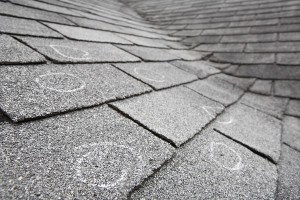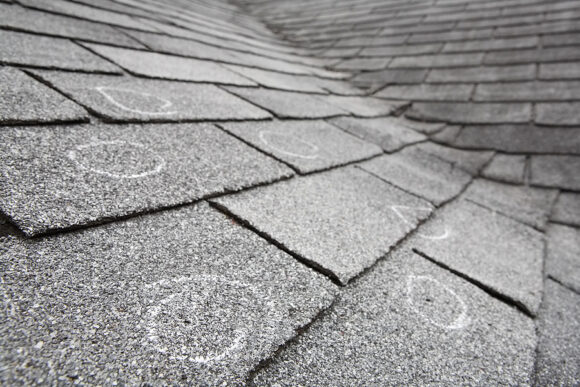Commercial roofing is one of the most demanding areas for expertise in the insurance industry today, as there are millions of commercial structures and hundreds of different roofing systems and variations in application. The history of a building’s roof may have a significant influence on its performance. There may be multiple layers of roofing on a single building, and the materials and their applications have changed over the years.
Roofing Systems
The three most common roofing systems are built-up roofing, modified bitumen roofing and single-ply roofing.
Built-up roofing comprises multiple layers of felt sandwiched together with molten asphalt, and typically covered with a protective coating or a roll-roofing cap-sheet. Built-up systems offer redundancy because of layers of reinforcements.
Modified bitumen roofing systems normally comprise a felt base sheet covered with a modified bitumen cap sheet. The modified bitumen cap sheet comprises reinforcement coated with asphalt mixed with a plastic or rubber to make the bitumen more tough and tear-resistant. The modified bitumen is covered with a protective coating such as aluminum-rich paint or granules to protect it from sun exposure.
Single-ply roof systems comprise a variety of plastics and rubbers: ethylene propylene diene monomer (EPDM), thermoplastic olefin/polyolefin (TPO) and polyvinyl chloride (PVC). These systems are single-layer applications of roofing sheets bonded along their seams with heat or adhesive. The seam bonds keep water from infiltrating the roofing. Single-ply systems are designed for direct exposure to sunlight.
When evaluating a roof system it is important to determine the constituents and attachment of the system.
Hail Damage
Hail storms typically have a predominant fall direction. The direction can be determined by examining building features on and off the roof. Hail can leave spatter marks on oxidized surfaces, such as electric junction boxes, and often leave evidence of impact as dents in metals such as air-conditioner cooling fins, roof vents and flashing. Roofing surfaces exposed to the predominant direction of hail-fall will exhibit damage first, and this damage should be the most severe.
Roofing systems installed over softer substrates are more susceptible to hail than those installed over stiffer substrates, which provide additional resistance to hail. Further, areas of ponded water can accelerate the deterioration of roofing membranes and make these areas more susceptible to impact.
Evaluation of large hail strikes against built-up and modified bitumen roof systems often requires the removal of roofing cores, which are transported to a lab. There, the sample is examined under magnification and the bitumen is removed from the core with solvent to examine the reinforcing for strain and tears characteristic of impacts. Hail damage to single-ply roofing systems typically is discernible in the field, but it may be helpful to remove cores from the roofing and examine certain areas with a microscope and/or high intensity backlighting to identify fractures caused by hailstone impacts.
Wind Damage
A building has widely varying force levels on its roof surfaces, and it is reasonable to expect the most severe wind damage to occur at the windward corners and edges of the roof where wind forces are the strongest. Building codes require more uplift resistance capacity for roofing in these areas. It is not uncommon for roof fastener patterns on shoreline structures and tall buildings to require 50 percent more fasteners along the edges and 100 percent more fasteners in roofing corners than in the field of the roof.
If wind forces have reached levels strong enough to damage the common commercial roofing systems, there typically is some combination of lifted, torn, and/or peeled back roofing concentrated where wind forces are the strongest at the windward edges and corners of the roof.
Additionally, examine roofing at roof penetrations looking for wrinkles and tears or any other evidence of roof membrane displacement. If roofing failure has occurred at wind speeds less than expected, examine and document the roof system attachment within those areas. Often premature failure occurs due to inadequate fasteners, inadequate adhesion, or some combination of the two. Situations such as these may be significant subrogation opportunities.
The layers of roofing, their attachments and their performance tell the story; we just have to know how to read it.
Kenneth R. Gilvary is a senior engineer at Haag Engineering.
Was this article valuable?
Here are more articles you may enjoy.


 California Bill Would Require Insurer Claims Handling Plans, And Double Penalties
California Bill Would Require Insurer Claims Handling Plans, And Double Penalties  First Brands Judge Approves Examiner to Probe Fraud Allegations
First Brands Judge Approves Examiner to Probe Fraud Allegations  Tesla, EEOC Plan Talks to Settle Factory Racism Suit
Tesla, EEOC Plan Talks to Settle Factory Racism Suit  Cyber Breach Affected 750,000 Canadian Investors, Regulator Says
Cyber Breach Affected 750,000 Canadian Investors, Regulator Says 